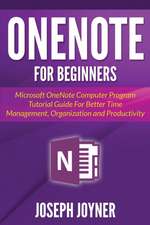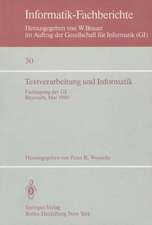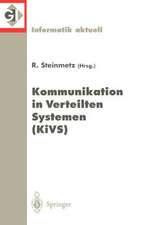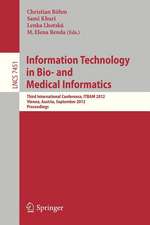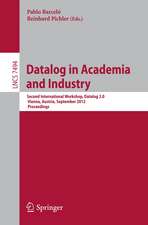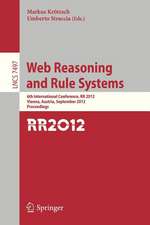Preserving Digital Information
Autor Henry Gladneyen Limba Engleză Hardback – 5 feb 2007
Leading industry consultant Henry M. Gladney outlines a technical solution and justifies its correctness and optimality. His presentation focuses on long-term digital preservation principles as a basis for producing the software that will be needed. The method described will work for any kind of digital document, multimedia file, business record collection, or scientific information, and is believed to be optimal with respect to both the quality of the preserved information and end-user convenience. Additionally, Dr. Gladney explains the requirements of the related software, and sketches how to implement it.
Preserving Digital Information presents an up-to-date description of its field, together with a solution for all technical problems identified in the pertinent professional literature. It is for archivists, research librarians, and museum curators who need to understand digital technology in order to manage their institutions; software engineers and computer scientists whose work requires sound information about digital preservation; and attorneys, medical professionals, government officials, and business executives who depend on the long-term reliability of digital records.
| Toate formatele și edițiile | Preț | Express |
|---|---|---|
| Paperback (1) | 334.71 lei 6-8 săpt. | |
| Springer Berlin, Heidelberg – 14 oct 2010 | 334.71 lei 6-8 săpt. | |
| Hardback (1) | 341.15 lei 6-8 săpt. | |
| Springer Berlin, Heidelberg – 5 feb 2007 | 341.15 lei 6-8 săpt. |
Preț: 341.15 lei
Preț vechi: 426.44 lei
-20% Nou
Puncte Express: 512
Preț estimativ în valută:
65.28€ • 68.34$ • 54.01£
65.28€ • 68.34$ • 54.01£
Carte tipărită la comandă
Livrare economică 05-19 aprilie
Preluare comenzi: 021 569.72.76
Specificații
ISBN-13: 9783540378860
ISBN-10: 3540378863
Pagini: 344
Ilustrații: XXIII, 319 p.
Dimensiuni: 155 x 235 x 25 mm
Greutate: 0.66 kg
Ediția:2007
Editura: Springer Berlin, Heidelberg
Colecția Springer
Locul publicării:Berlin, Heidelberg, Germany
ISBN-10: 3540378863
Pagini: 344
Ilustrații: XXIII, 319 p.
Dimensiuni: 155 x 235 x 25 mm
Greutate: 0.66 kg
Ediția:2007
Editura: Springer Berlin, Heidelberg
Colecția Springer
Locul publicării:Berlin, Heidelberg, Germany
Public țintă
Professional/practitionerCuprins
Why We Need Long-term Digital Preservation.- State of the Art.- Economic Trends and Social Issues.- Information Object Structure.- to Knowledge Theory.- Lessons from Scientific Philosophy.- Trust and Authenticity.- Describing Information Structure.- Distributed Content Management.- Digital Object Formats.- Archiving Practices.- Everyday Digital Content Management.- Digital Object Architecture for the Long Term.- Durable Bit-Strings and Catalogs.- Durable Evidence.- Durable Representation.- Peroration.- Assessment and the Future.
Recenzii
From the reviews:
"The book provides a wide range of examples that illustrate the various types of information. It is for producers and users who may be interested in long-term archiving and retrieval of digital information. This book states that today there is no single solution that will work for the many kinds of digital information being used by many different users. … Gladney is an expert on this subject, and this book offers a thorough treatment of it." (Stan Kurkovsky, ACM Computing Reviews, Vol. 49 (8), August, 2008)
"The book provides a wide range of examples that illustrate the various types of information. It is for producers and users who may be interested in long-term archiving and retrieval of digital information. This book states that today there is no single solution that will work for the many kinds of digital information being used by many different users. … Gladney is an expert on this subject, and this book offers a thorough treatment of it." (Stan Kurkovsky, ACM Computing Reviews, Vol. 49 (8), August, 2008)
Notă biografică
Henry M. Gladney is an industry consultant for digital preservation and document management. In 2001, he founded his own company, HMG Consulting, based in Saratoga, CA, after having worked for IBM Research for decades, designing – among other systems – a digital library service that is the core of today's IBM Content Manager®. He is a regular author in the top ACM periodicals, holds eleven patents, and produces the "Digital Document Quarterly", an online newsletter that has discussed preservation extensively.
Textul de pe ultima copertă
Cultural history enthusiasts have asserted the urgent need to protect digital information from imminent loss. Without action, much of what has been created in digital form is likely to become unusable. Although a decade has already elapsed since this challenge was clearly articulated, nobody has described a complete procedure for preventing such loss – until now.
Leading industry consultant Henry M. Gladney outlines a technical solution and justifies its correctness and optimality. His presentation focuses on long-term digital preservation principles as a basis for producing the software that will be needed. The method described will work for any kind of digital document, multimedia file, business record collection, or scientific information, and is believed to be optimal with respect to both the quality of the preserved information and end-user convenience. Additionally, Dr. Gladney explains the requirements of the related software, and sketches how to implement it.
Preserving Digital Information presents an up-to-date description of its field, together with a solution for all technical problems identified in the pertinent professional literature. It is for archivists, research librarians, and museum curators who need to understand digital technology in order to manage their institutions; software engineers and computer scientists whose work requires sound information about digital preservation; and attorneys, medical professionals, government officials, and business executives who depend on the long-term reliability of digital records.
Leading industry consultant Henry M. Gladney outlines a technical solution and justifies its correctness and optimality. His presentation focuses on long-term digital preservation principles as a basis for producing the software that will be needed. The method described will work for any kind of digital document, multimedia file, business record collection, or scientific information, and is believed to be optimal with respect to both the quality of the preserved information and end-user convenience. Additionally, Dr. Gladney explains the requirements of the related software, and sketches how to implement it.
Preserving Digital Information presents an up-to-date description of its field, together with a solution for all technical problems identified in the pertinent professional literature. It is for archivists, research librarians, and museum curators who need to understand digital technology in order to manage their institutions; software engineers and computer scientists whose work requires sound information about digital preservation; and attorneys, medical professionals, government officials, and business executives who depend on the long-term reliability of digital records.
Caracteristici
Describes methodology for long-term preservation of all kinds of digital documents Justifies this methodology using 20th-century theory of knowledge communication Outlines the requirements and architecture for the software needed Emphasizes attention to the perspectives and needs of end users Includes supplementary material: sn.pub/extras






